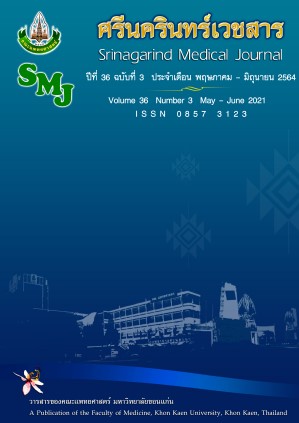ความชุกและปัจจัยที่เกี่ยวข้องกับการเกิดภาวะเมตาบอลิกซินโดรม ในโรงพยาบาลส่งเสริมสุขภาพ ศูนย์อนามัยที่ 7 ขอนแก่น
Abstract
บทคัดย่อ
หลักการและวัตถุประสงค์: ภาวะเมตาบอลิกซินโดรมเป็นสาเหตุสำคัญของการเกิดโรคหัวใจและหลอดเลือด ความชุกของภาวะเมตาบอลิกซินโดรมมีแนวโน้มเพิ่มขึ้นทั่วโลกผู้วิจัยต้องการศึกษาความชุกและปัจจัยที่มีความสัมพันธ์กับการเกิดภาวะเมตาบอลิกซินโดรมในโรงพยาบาลส่งเสริมสุขภาพ ศูนย์อนามัยที่ 7 ขอนแก่น เพื่อวางแผนการดูแลต่อไป
วิธีการศึกษา: เป็นการศึกษาเชิงวิเคราะห์แบบภาคตัดขวาง กลุ่มตัวอย่าง จำนวน 302 ราย คัดเลือกกลุ่มตัวอย่างแบบสะดวกจากผู้เข้ารับการตรวจสุขภาพ ที่คลินิกส่งเสริมสุขภาพ โรงพยาบาลส่งเสริมสุขภาพ ศูนย์อนามัยที่ 7 ระหว่าง 15 มกราคม- 15 มีนาคม2564 ใช้เกณฑ์การวินิจฉัยภาวะเมตาบอลิกซินโดรมของ modified NCEP ATPIII 2005 หาความชุกของภาวะเมตาบอลิกซินโดรมคิดเป็นร้อยละของประชากรและวิเคราะห์ความสัมพันธ์ของปัจจัยสุขภาพกับการเกิดภาวะเมตาบอลิกซินโดรมโดยใช้ 2-sided Chi-square และ Multiple logistic regression analysis
ผลการศึกษา: พบความชุกของการเกิดภาวะเมตาบอลิกซินโดรมร้อยละ 32.78 (ร้อยละ 23.71 ในเพศชาย, ร้อยละ 25.66 ในเพศหญิง ในกลุ่มที่อายุน้อยกว่า 60 ปี และ ร้อยละ 52.94 ในเพศชาย, ร้อยละ 50 ในเพศหญิง ในกลุ่มที่อายุมากกว่าหรือเท่ากับ 60 ปี) ปัจจัยที่มีความสัมพันธ์กับการเกิดภาวะเมตาบอลิกซินโดรม ได้แก่ อายุ ดัชนีมวลกาย การสูบบุหรี่ ประวัติโรคไขมันในเลือดสูงของคนในครอบครัว และกิจกรรมทางกาย
สรุป: ความชุกของภาวะเมตาบอลิกซินโดรมพบได้ประมาณ 1 ใน 3 ของประชากร ควรให้มีการค้นหาและปรับเปลี่ยนปัจจัยที่เกี่ยวข้อง เพื่อป้องกันการเกิด ภาวะเมตาบอลิกซินโดรมต่อไป
คำสำคัญ ภาวะเมตาบอลิกซินโดรม; ความชุก; ปัจจัยที่เกี่ยวข้อง
Abstract
Objective: Metabolic syndrome is one of the most important causes of cardiovascular and cerebrovascular diseases. Nowadays, the global prevalence of metabolic syndrome has been increased. The authors aimed to study the prevalence and the associated factors of metabolic syndrome in Health Promoting hospital, Regional health promotion center 7, Khonkaen.
Method: This was an analytical cross-sectional study, A convenience sample composed of 302 persons who came for check up at health promotion clinic, in health promoting hospital, Regional health promotion center 7, during 15 January - 15 March 2021. Metabolic syndrome was diagnosed by using modified NCEP ATP III 2005 criteria. The prevalence of metabolic syndrome was calculated. The significant health factors related to metabolic syndrome were analyzed, using 2-sided Chi-square and logistic regression analysis.
Results: The overall prevalence of metabolic syndrome was 32.78 % (23.71% in men, 25.66 % in women who age< 60 years and 52.94% in men, 50% in women who age >60 years). Factors that were significantly related to metabolic syndrome were age, body mass index, smoking, physical activity, and familial history of dyslipidemia.
Conclusion: Nearly one-third of the population in our study had metabolic syndrome. It is important to find the related factors that should be mainly focused to modify and prevent the metabolic syndrome.
Keywords: Metabolic Syndrome; Prevalence; BMI; Associated factors


